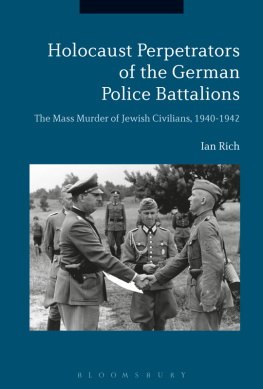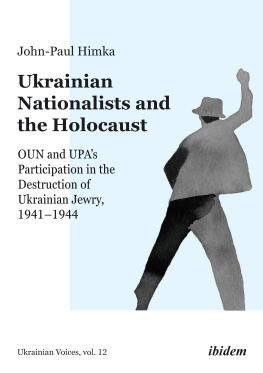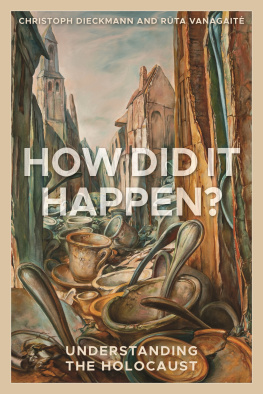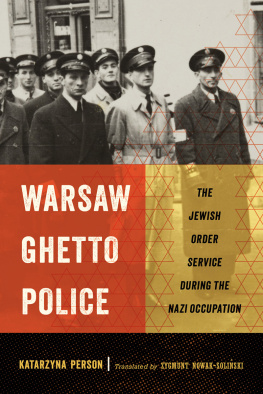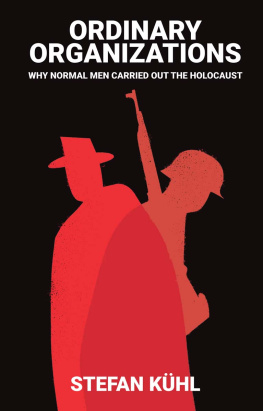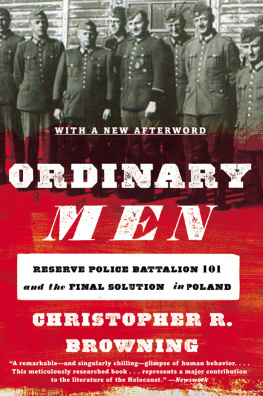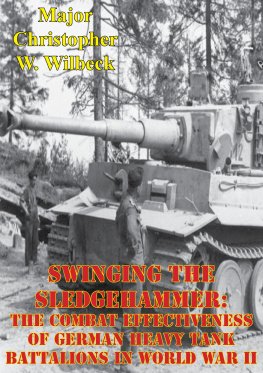Holocaust Perpetrators
of the German Police Battalions
Also available from Bloomsbury
The Image of the Soldier in German Culture, 18711933, by Paul Fox
Reverberations of Nazi Violence in Germany and Beyond, edited by Stephanie Bird, Mary Fulbrook, Julia Wagner and Christiane Wienand
Violence and the German Soldier in the Great War, by Benjamin Ziemann
Holocaust Perpetrators
of the German Police Battalions
The Mass Murder of Jewish Civilians,
19401942
Ian Rich

I would like to take the opportunity to thank a few people for their help. Robert Bierschneider, Mike Hawkins, Peter Longerich, Wendy Lower, A. Dirk Moses and Philip Spencer all helped me with the research that went into this book and made helpful suggestions along the way. I would like to thank Tricia Logan, Richard Overy, Nikolaus Wachsmann and the anonymous reviewers for taking the time to read parts or full drafts of this work and for their thoughtful and insightful comments and suggestions. Any remaining errors are my responsibility. Finally thank you to Dan Stone whose guidance, support and generosity are very much appreciated indeed.
BAB | Bundesarchiv Berlin |
BAK | Bundesarchiv Koblenz |
BDC | Berlin Document Centre |
BDM | Bund Deutscher Mdel |
BdO | Befehlshaber der Ordnungspolizei |
DJ | Deutsches Jungvolk |
DGIV | Durchgangsstrasse IV |
GCCS | Government Code and Cypher School |
HGS | Holocaust and Genocide Studies |
HJ | Hitler Youth |
HSSPF | Hherer SS- und Polizeifhrer |
JGR | Journal of Genocide Research |
JuNS | Justiz und NS Verbrechen |
KdO | Kommandeur der Ordnungspolizei |
Lapo | Kasernierte Landespolizei |
LSAH | SS-Leibstandarte Adolf Hitler |
MBI | Mitteilungsbltter fr die Weltanschauliche Erziehung der Ordnungspolizei |
NA | National Archives, London |
NSKK | Nationalsozialistisches Kraftfahrkorps |
OK | Ortskommandantur |
OT | Organisation Todt |
PID | Politischer Informationsdienst |
PRC | Police Regiment Centre |
PRS | Police Regiment South |
RAD | Reichsarbeitsdienst |
RSHA | Reichssicherheitshauptamt |
SD | Sicherheitsdienst |
SS-TV | SS-Totenkopfverbnde |
SS-VT | SS-Verfgungstruppen |
SSO | SS Organizations |
USCF | USC Shoah Foundation Visual Archive |
WO | War Office |
ZStL | Zentrale Stelle Ludwigsburg |
In this book I identify a vanguard group within Police Battalions 304 and 314 and examine the impact of this group on the actions of the battalions as whole units. I argue here that a distinct group of young junior officers that occupied the positions of company and platoon leaders in Police Battalions 314 and 304 had a disproportionate influence not only on the culture and behaviour of their sub-units, but also collectively on the actions of the battalions as whole units. These men were part of a relatively homogenous group that was distinct from the other members of the police battalions and were specially selected and trained to fill the roles of the platoon and company leaders. This group of young officers who filled these pivotal positions were considered by the SS-police hierarchy to represent the future generation of SS leaders and an ideological vanguard of the police battalions. As a group these men can be considered to be among the vanguard perpetrators of the Holocaust that had a disproportionate influence on the evolution and radicalization of the mass murders in eastern Europe. This group was fast-tracked into becoming officers and all attended the same police officer training school in Berlin-Kpenick. Immediately following the course these men, with an average age of twenty-three in 1941, were deployed to their battalions either in Poland where the battalions were involved in the enforcement of Nazi racial policies, or in Ukraine at a time when the battalions were engaged in the mass murder of Jewish civilians. The influence of this group of perpetrators on the killing process will be examined within the context of the actions of Police Battalions 314 and 304, units that were operating directly at the forefront of some key stages of the mass murder process in eastern Europe.
The theoretical framework for this book follows the work of Michael Wildt on the leadership cadre of the RSHA.youth that represented a break from the past and focus on the future as they perceived themselves to be the natural future leadership elite. Wildt argues that the fundamental characteristic of this group was to translate ideas into active leadership, to turn theory into practice. The dominant structure of identity for this group was a National Socialist world view which functioned as a release from regulatory norms, including moral and legal norms, an ideological stance that was to create the scope for leadership based on unrestrained initiative and dynamic radicalism. The group biography of the young junior officers of the police battalions resembles Wildts uncompromising generation in that they joined Nazi organizations at a young age, were all relatively well educated and came from lower-middle and middle-class backgrounds. This book will demonstrate how the values based on active leadership, unbound by moral or legal norms, the same values that infused the leadership of the RSHA, were transferred through the ideological training of the young police officers, former Hitler Youth (HJ) leaders, who were intended to become the next generation of elite leaders of the SS and police ranks. It will then demonstrate how these values were translated into action in Poland and Ukraine by this vanguard group.
In the following pages I will recreate the profiles, preparations and actions of Police Battalions 314 and 304 in order to assess the ideological, organizational and situational factors that contributed to the behaviour of the men that made up the battalions. The Ordnungspolizei (Orpo) battalions were at the forefront in implementing Nazi racial policy in Poland following the Nazi invasion in 1939 and the battalions that were assigned to eastern Europe during the early stages of the German invasion of the Soviet Union in 1941 proved to be the decisive factor in carrying out the campaign of mass murder. Battalions 314 and 304 were two of the six Orpo battalions assigned to the HSSPF Russia South, Friedrich Jeckeln, which were collectively involved in the murder of considerably more Jews in Ukraine than Einsatzgruppen C and D combined. As Dieter Pohl has commented, the Orpo formed the backbone of manpower for Jewish actions in Ukraine.roles and contrasts can be drawn not only between the officer corps and the men of the rank and file, but also within the officer ranks themselves. During the recreation of the actions of the battalions, I show that the battalions were often separated into subgroups, usually at company or platoon level, that were led by the junior officers. By recreating the biographies and preparations of the battalions and showing how these relate to the behaviour of the units in Poland and Ukraine, I identify the emergence of radical elements within the battalions, elements that included the junior officer group, and how they influenced the actions of the battalions as whole units.
Next page
